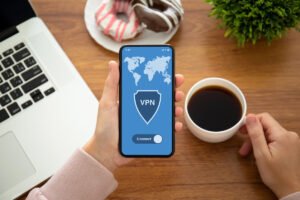Parental controls for the Oculus Quest? They don’t exist, but we have a few steps to make sure your family is protected while using this VR device.
If you just purchased your family an Oculus Quest One or Two, you could have just handed them a web browser and device with absolutely zero content filtering options and no parental controls. What could go wrong? We searched and searched for parental controls built into the software for the Oculus Quest, and…they don’t exist. The Oculus Quest doesn’t currently have any built-in web filter or parental controls by default, and for parents, that’s gotta be a little concerning. We wanted to create this guide to show you the best available methods for blocking and filtering explicit content on the Oculus Quest. We’ll cover what you can do as a parent in the browser settings, Facebook settings, the Oculus app, and your home environment.
Oculus Quest Browser Parental Settings
One of the most important and crucial parental control settings is the Oculus web browser. Every Oculus Quest has a fully functional web browser that cannot be disabled. There are some ways to uninstall it with SideQuest, but it is not recommended and can wreck your entire system. Worse, the web browser has no content filtering by default. To implement this content filter, you’re going to have to jump into the Oculus headset and change a few settings. If you’ve never jumped into a VR headset before, we recommend you play around in the VR environment to get familiar with the way the VR ecosystem works. It can be tricky at first, but you should be able to pick up on it fairly quickly. Once you’re inside and feel comfortable with the headset, you’re going to be met with a virtual environment. Don’t hesitate to ask your kids for help if you need it.
- From here, on your RIGHT controller, you want to hit the button that has the Oculus logo on it. This will bring up the Oculus menu.
- Once you’re in the menu, you will want to click on the Apps tab and go into Browser. This will pull up the Oculus browser.
- You’re going to change some settings here to make it safe. First and foremost, you’re going to go over to the triple dots, click on those and go into settings.
Leveraging Your Google Account For Parental Control
As a side note, you may have to sign in to your Google account to perform this content filtering option.
- Once you’re inside the settings in the Oculus browser, you’re going to make sure the default search engine is set to Google.
- Exit out of this tab by clicking little X. Go into the Search settings in your Google account and make sure you have “Safe Search” checked on.
What does this do? You do this because “Safe Search” is Google’s default content filter, which filters out explicit content like pornography. If you have this checked on, it should filter out many pornographic sites and graphic content. So, anyone that uses the Oculus Quest headset won’t be able to access questionable content. Again, this is not a perfect content filter. There are obviously a thousand other ways to access explicit content, but this is literally one of the best ways we could find to keep the bad things off of your Oculus web browser. Once you have “Safe Search” turned on, go down to the very bottom of the page and hit “Save.”
Oculus Quest Parental Control At The Wi-Fi Router Level
Leveraging Google is most likely not enough protection, so there are a couple of other workarounds you can do to prevent your child from being exposed to explicit content on the web via the Oculus Quest device. If you have a Wi-Fi router that was set up using an application on your smartphone, then most likely, that router has some sort of content filtering method built right into it. For example, on a Google Nest Router, there is a setting that, when toggled ON, blocks all adult websites and as much explicit content as Google could possibly think of. But if your Wi-Fi doesn’t have a setting like this, you can always call your internet service provider and ask them about the content filtering options they have available. You can get similar parental control features as the Google Nest Router by also using Firewalla or the Eero Mesh Wi-Fi. As a general best practice for parenting controls for your internet and devices connected to your network, we highly advise investing in one of these awesome mesh Wi-Fi routers. Not only do you get an optimized signal throughout your home, but you can also set up some effective filtering settings.
Enhanced Facebook Settings For Oculus Quest Parental Controls
Another key component to parental controls for the Oculus is the settings on the Facebook profile you’re using for your Oculus Quest headset. You are required to sign in with a Facebook account with your Oculus device. And again, it is possible to see explicit content on Facebook. We’re going to cover a handful of settings and recommendations we’d suggest making that could potentially help prevent your children from seeing explicit content on Facebook and will add another layer of protection when using this VR device. Aside from protecting your family from explicit content, these recommendations are also going to prevent your child from being preyed upon by people who use platforms like Facebook and VR chat rooms to find vulnerable children. It’s sad, but it happens.
Use Oculus Quest to sign in with your Facebook account.
Unfortunately, you will need to have a Facebook account with your Oculus Quest. This means either you or your child will have to create a Facebook account and sign in to use your Oculus Quest. Again…if you’re smart, as a parent, you will use your own Facebook account so you can monitor and control access. Warning: Do NOT make a fake Facebook account. There have been some reports that people who do this have had their Oculus Quest disabled. When this happens, you lose all of your purchases with no chance of getting a refund or getting them back. When games you purchase range from $15 to $30, that’s a hefty price tag just to create a fake account, which doesn’t provide any privacy advantages anyway. The best recommendation would be to use your personal Facebook account when setting up the Oculus Quest. Make sure the following settings are implemented. You can either do this through the Facebook mobile app or on the desktop. Navigate to the Privacy Settings tab and make sure as many things as possible are either set to “Only Me” or “Disabled.” The most important section to make sure everything is set to “Only Me” is the “How People Find and Contact You” section. You should definitely spend a bit of time looking through these various settings and getting to know what they mean and how they affect your account.
Enhanced Parental Control Settings In The Oculus App
In the Oculus Quest app, go to the settings by clicking on the top left-hand corner. Once you’re in the privacy settings, make sure that “Activity” is set to “Only Me,” your friend’s list is set to “Only Me”, your Facebook name is set to “Only Me”, and Activity Status + Push Notifications is set to “Only Me.” Now, you’re probably thinking, ‘I’m going to be a ghost on Facebook after making these adjustments.’ And you’d probably be right. But until we get built-in parental settings in the Oculus Quest environment, we will have to resort to these secondary measures to make sure we get optimal or adequate parental controls. And don’t forget, you can change these settings later. But if you’re looking for the safest and most private settings on the Oculus Quest, you’ll want to implement these.
Research Gaming Content Before You Buy
Games are another access point for potential threats and explicit content on the Oculus Quest. First off, there are a ton of great games available through the Oculus Quest store and even some indie stores like App Lab and SideQuest. We are just beginning to scratch the surface of possibility and wonder when it comes to VR gaming. But that also means enhanced threats from the dangers lurking. As of now, most of the major sources for Oculus Quest games all have a very strict no adult content policy. But who are we kidding? You need to be aware that there are game ratings for VR games as well (Mature, Teen, Everyone 10+ and Everyone). Even with those strict no adult content policies, there are still games and apps which allow people to share explicit content in-game. To keep your family safe, be sure that when you set up the headset, you install the Oculus App on your mobile device and enable the “Purchase Pin.” What this does is all purchases will require that a pin be used. Not only will this save you money from unwanted purchases, but it’ll also allow you to know all the apps and games being installed on the Oculus Quest headset. Again, a simple and quick additional layer of control. If you don’t currently have the pin setup or you didn’t set up the headset using your smartphone, don’t worry just download the Oculus app and set up the headset with it.
Be Smart. Be Aware
There are a couple of other things you can do outside of an app or some setting in the software. Talk to your kids about how they’re using the Oculus Quest device. You’ll be surprised by what revelations and intuitions you have just by simply talking to your kids about their tech habits. Another level of protection is to dedicate an area in your house where the Oculus Quest can be played. Now, this might be a little difficult at first because your family may want to watch some movies or engage in educational VR content (thank you Amazon Prime VR!). It can be uncomfortable or difficult doing that with a lot of people around. But…having a dedicated space in the home (like a commons area) where the Oculus Quest VR can be played or used is an effective parenting hack.
What Does DDID Use?
Great question; I finally came up with a system that is the best solution for our home. Not only did I use the above settings for my teen son, but I also use a Firewalla device. This device allows me to control when a device has internet access (I have rules to turn off the Oculus at 10 pm on weekdays and 11 pm on weekends), I’m able to block YouTube, Netflix, any video streaming, and I can either drop all social media connections or get specific. The Firewalla is used for all our devices to help keep our network protected and safe. The Oculus Quest also has a feature that will cast what the player is playing/doing to a TV. The DDID family requires that this feature be turned on so;
- We can watch what our kids are playing/doing.
- We can watch what our kids are playing/doing It’s psychological. People, in general, will make better choices knowing that someone might be watching.
Again, no content filter is perfect. Kids are smart. Kids can find a way. They can be really good at circumventing any measure you put in place to protect them. Even in the safest VR apps, your child could still be exposed to vulgarity or inappropriate actions of others. That is why one of the best things you can do as a parent to keep your child safe in a VR environment is to jump in and play with them.
Engage in their world. Be part of it. Be an active parent. Not a helicopter parent, but one who is smart and aware of what’s happening in their child’s lives. This is the best and safest method for you as a parent to know exactly what your child or loved one is experiencing in virtual reality.








